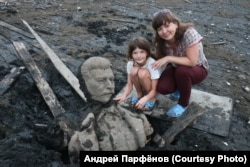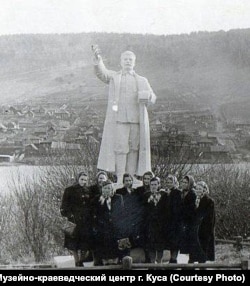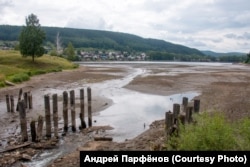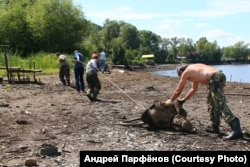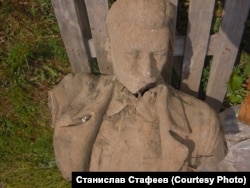In the powerful, perestroika-era film Repentance, the corpse of a Stalin-like local official mysteriously appears again and again, despite efforts by locals to bury him and turn their backs on the consequences of his crimes.
Now the town of Kusa in Chelyabinsk Oblast is experiencing something eerily similar, with the specter of the late Soviet dictator appearing unexpectedly from the past and tearing open old wounds.
Earlier this month, local officials began repairs on a 200-year-old dam on the Kusa River by lowering the water level in the pond behind it. On August 2, local photographer Andrei Parfyonov and his family were walking along the muddy bank when they found themselves staring into the stern face of Josef Stalin.
"Think back to a time 60 years ago, when Stalin died [in March 1953] and Nikita Khrushchev said we need to end the cult of personality," says Natalya Rostovtseva, director of the Kusa Historical Museum. "A monument to Stalin stood in the city park, the only one in the city, a favorite location where locals relaxed. Many local residents said it was made of cast iron. Others said it was bronze."
Shortly after Soviet leader Khrushchev's so-called secret speech to the 20th Soviet Communist Party Congress in February 1956 partially denouncing Stalin's crimes, local residents pulled down the statue, broke it into pieces, and threw the chunks into the pond through holes cut in the ice.
"We at the museum had been hoping to find the pieces for a long time," Rostovtseva continues, describing how Parfyonov called her with news of his discovery. "My husband and I drove right over, and another worker at the museum came. We confirmed that it was a fragment of the upper part of the monument."
She says one reason the museum failed to find the statue earlier was that it was on the opposite side of the pond from where the monument had originally stood.
Rostovtseva and her colleagues were able to establish that the statue was, in fact, made of concrete "of quite good Soviet quality." The head and chest were largely intact, except for damage to the area around the neck from which, apparently, the statue had been pulled to the ground.
The following day, Rostovtseva, Mayor Valery Vasenyov, and an "improvised committee" of local dignitaries gathered around the concrete dictator to decide his fate. It was decided to gather all the fragments and display them in the courtyard outside the town museum.
"We planned to allow free access for around three weeks and then, in early September...we would take it into the museum and formulate a plan for its further display. We would conserve it after consulting with specialists," she says.
"I didn't think we should restore the monument in the city, but a decision on that would have to be made by the mayor and the head of the region in consultation with the public and with veterans."
It was determined that the fragments would be removed on August 6 to give time for journalists and others from Chelyabinsk and farther afield to attend the event.
That's when things got weird.
Over the weekend, a group of people representing the local branch of a pro-Kremlin, pro-Stalin public organization called Essence of the Age swept in and carted the Stalin fragments away. The group was headed by a local businessman named Sergei Stafeyev, with whom Rostovtseva had already had run-ins.
The group announced plans to restore the statue and erect it on a public square in Kusa.
At a press conference in Chelyabinsk on August 10, Stafeyev said he doesn't have confidence that local authorities can handle the Stalin statue properly considering the "lamentable condition" of other Soviet monuments in Kusa, including a statue of Vladimir Lenin that still dominates the town's Revolution Square.
Although Stafeyev denied his group "stole" the statue, he said he has no intention of returning it.
"They want to display it in pieces like it was found -- just cleaned up and laid out," he said. "But we want to restore it and re-erect it. We will conduct a referendum."
Stafeyev claimed a survey has already been conducted on the VK social-media site that showed that "80 percent" of respondents want the statue returned to a place of honor.
"This is our history," he said. "Stalin is a figure who has been widely slandered. There are various opinions about his personality, but thanks to him, we won the war. Take the United States. No one there is lamenting and punishing themselves about the things their leaders did. Look at the Great Depression. How many people starved to death? No one is now saying it was 'genocide against their own people.' They just call it the Great Depression.
"In my father's family, there were also some people who were repressed," Safeyev added. "But that isn't the whole story. For one thing, Stalin didn't sign the orders personally. For another, the concept of 'repression' doesn't always mean that they were shot. And third, we need to establish exact figures, to publish them, and to agree what is the truth and what is false."
Kusa is a fascinating backdrop for this controversy. The town of some 18,000 people was founded in 1778 when some 50 serf families were relocated there to build an ironworks. They also built the dam that is currently under repair.
The original ironworks became the foundation of the current Kusa Foundry and Machine-Building Factory, which is still the town's monopoly employer. The plant was once known for its decorative iron pieces, including busts of cultural figures, but it now only rarely makes such pieces -- although it has produced a bust of President Vladimir Putin that is on display in Rostovtseva's museum.
The town also got off easily during Stalin's reign, says local pensioner Anatoly Blinovsky, who has written two books about the local history of the period. According to Blinovsky, not more than "60 or 70" people from Kusa were repressed under the dictator.
Although Blinovsky's own father was a victim of Stalinism, the historian refuses to pass judgment on the period.
"The debate [about the Stalin monument] is going on," he says. "People are talking about it and the newspapers are writing about it. I think that life itself, history itself, will find a place for these remains. It isn't for us -- the close relatives of those people [who lived under Stalin] -- to judge Stalinism. There is still too much subjective pain.
"There are still people alive who are descendants of the repressed and of those who did the repressing," he adds. "It isn't for us to judge who is more guilty: the repressed or the repressors. We will only be able to look at these things objectively in five or even eight generations. The monument was erected by people of that period. And it was torn down by people of that same period."
Stalin's legacy puts Kusa in a difficult place, Blinovsky argues.
"I wrote two books, one about Kusa and one about Yemanzhelinsk, where I grew up," he explains. "They are completely different. Yemanzhelinsk is populated about 90 percent by descendants of the repressed. But Kusa was only slightly touched by the Terror -- just individual cases. That is why Kusa is in a complicated situation now. It is an isolated town. It has always been a backwater.
"People here have their own ways of thinking," he says. "Since the repressions didn't affect them strongly, their attitude toward them isn't clearly formed. Some think it was wrong and some think the contrary. But a clear majority has not yet formed on one side or the other."





